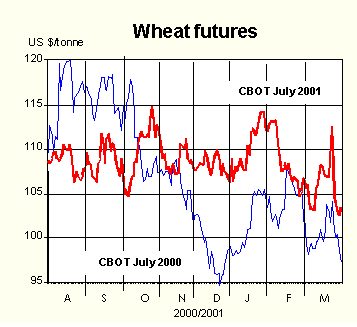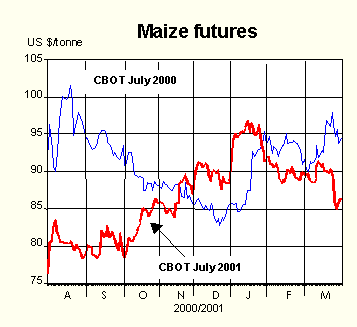


In recent months world cereal prices have remained under downward pressure largely as a result of ample exportable supplies and slower pace of growth in demand. The weakness in cereal prices is likely to continue into the next season, given a likely increase in the overall cereal production in 2001, prospects for some slackening in global economic growth and continued uncertainties surrounding the impacts of recent animal diseases on both production and demand for meat products (for more details see the utilization section).
Among the major cereals only wheat prices remain above last year. The main reason is stronger demand for high quality milling wheat. Since January, the US hard wheat export prices have remained stable at around US$134 per tonne, up by more than US$20 per tonne from the corresponding period in the previous season. On the other hand, export prices for the US soft wheat followed a declining trend since January and are currently traded at only US$5 per tonne above last year's reduced levels. During recent weeks, large exports from India and bigger sales from major exporters other than the United States have also had negative impacts on US export prices. In the futures market, slower sales from the United States coupled with a generally favourable production outlook for 2001, and spillover weakness from the plunging equities markets, continued to weigh on the Chicago Board of Trade (CBOT) soft red winter prices. By late March, the July wheat contracts were quoted at US$104 per tonne, converging closer to prices during the corresponding period in 1999.


All through the current season, international maize prices have remained generally below the previous season's already low levels. By March, the US maize export prices averaged US$92 per tonne, a further US$3 per tonne drop since January, and also US$3 per tonne below March 2000. Despite a likely increase in export volume from the United States, the US export prices remain under continued downward pressure. Several reasons contribute to this development, including large sales from China and renewed large exportable supplies in Brazil. The continuing weakness in maize markets is also reflected by the performance of prices in the CBOT futures market. Over the past months, the July maize futures continued to slide and by March they were quoted at US$87 per tonne, some US$9 per tonne down from the corresponding period last year. However, the sluggish performance of the US maize futures also reflect the impact of slowed US sales to some Asian markets following the discovery of GM-contaminated maize and the recent plunge in world financial markets which could undermine economic growth prospects and, hence, reduce demand for meat products and also lower the demand for feed grains.
| 2001 | 2000 | ||
| March | Jan. | March | |
| (. . . . . . US$/tonne . . . . . .) | |||
| United States | |||
| Wheat 1/ | 134 | 134 | 112 |
| Maize | 92 | 95 | 95 |
| Sorghum | 99 | 104 | 95 |
| Argentina 2/ | |||
| Wheat | 119 | 120 | 98 |
| Maize | 81 | 84 | 85 |
| Thailand 2/ | |||
| Rice white 3/ | 181 | 187 | 232 |
| Rice, broken 4/ | 127 | 134 | 151 |
International rice prices recovered slightly in January and February before falling again in March, as fresh supplies arrived into the market in some major exporting countries and import demand remained subdued. The FAO Export Price Index for rice (1982-84=100) fell accordingly to 92 percentage points, down from the average of 94 points in December 2000.
Thai Government market intervention in February sustained the price of high quality Thai 100% B rice, which rose from US$187 in December 2000 and January 2001 to US$190 per tonne in February. It has since resumed its slide and tumbled to US$181 per tonne in March. By contrast, the price of the US N.2/4 long grain N.2/4% has kept firm, resulting in a widening of the price differential with the Thai 100% B rice.
The price of the low quality, fully broken rice (Thai A1 Super), which had also strengthened in reaction to Thai Government purchases, dipped steeply to US$127 per tonne in March, from US$136 February.

Barring a major supply or demand shock, world prices are expected to remain under pressure at least until mid-year, when more information on the extent of adjustment to lower prices on 2001 rice production prospects in the northern hemisphere becomes available.